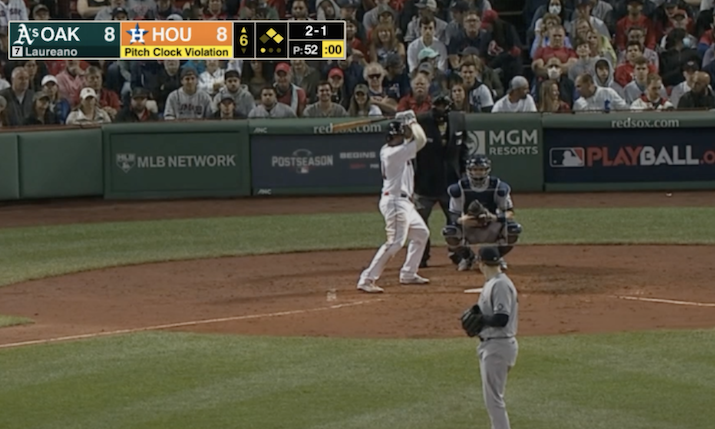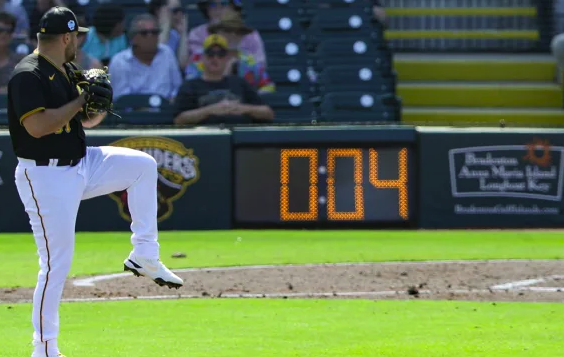Here’s How ESPN’s MLB Production Team Is Adapting to the New Pitch Clock
Rule changes spur broadcasters to modify their approach to baseball coverage
Story Highlights
The first pitch of the 2023 MLB season has yet to be thrown, but much has already been made of the new pitch clock. Although the new rule — one of several intended to improve the pace of play this season — has forced pitchers and hitters to dramatically rethink their routines, broadcasters like ESPN are having to alter their approach to covering the game.

“Whenever there are big rule changes like this, every [broadcaster] has to address and deal with documenting the action as the primary goal and using your discretionary time to the best of your ability,” says ESPN VP, Production, Phil Orlins. “Obviously, it feels like a dominant storyline during Spring Training, and I think it’s going to feel like an important storyline the first couple of weeks of the season. But I do think it’s going to naturally ebb and flow to where it becomes more routine as time goes on — for [broadcasters], players, and fans.”
Orlins has a basis for the claim: the pitch clock was tested in the minor leagues last season, and violations dropped dramatically as players got more accustomed to the rule. Nonetheless, as the age of the pitch clock begins, production teams and announcers have had to fundamentally change the way they present the game to fans.
How the Pitch Timer Works
As a result of the 30-second pitch timer between batters — along with the elimination of defensive shifts and addition of enlarged bases — games that previously pushed well past the three-hour mark are taking 2½ hours or less during Spring Training.
According to the official MLB rulebook, between pitches, a 15-second timer will be in place with the bases empty and a 20-second timer with runners on base. The pitcher must begin his motion to deliver the pitch before the expiration of the pitch timer. Pitchers who violate the timer are charged with an automatic ball. Batters who violate it are charged with an automatic strike. Batters must be in the box and alert to the pitcher by the 8-second mark or be charged with an automatic strike.

MLB is instituting a 30-second pitch timer this season.
With runners on base, the timer resets if the pitcher attempts a pickoff or steps off the rubber. Pitchers are limited to two disengagements (pickoff attempts or step-offs) per plate appearance, but the limit is reset if a runner or runners advance. In the event of a third, unsuccessful pickoff attempt, the runner automatically advances one base.
Learning Curve During Spring Training
The most important issue for broadcasters is how to present the pitch clock on-screen. Although most agree that it should be integrated into the miniboard (or scorebug) graphic, the debate continues on when: whether it should appear only during key moments (for example, 10 seconds left) or for the entire 30 seconds.
During Spring Training, many broadcasters were not given access to the pitch-clock data until seven seconds were left on the clock. As a result, many have opted to integrate the old-school “camera shot of the clock” (reminiscent of the NBA’s shot clock half a century ago) into the miniboard graphic. During Spring Training coverage, ESPN puts the camera shot of the pitch clock just to the right of the miniboard graphic.
“The way our miniboard lays out with a horizontal rectangle layout,” notes Orlins, “it happened to be easy to align the old-school camera shot alongside the miniboard and still work within our established space. It was definitely good to Get some Spring Training in [with the pitch clock], but, that said, we expect to get to the API-triggered data version in the miniboard on Opening Night and integrated into that same amount of space where we did the camera shot.
“We’re confident,” he continues, “that we’re going to get access to the API for the pitch clock much earlier [in the at-bat] by Opening Night. We’re in discussions on that right now. I think it’s absolutely mandatory that we have it [displayed] before eight seconds since the batter has to be in the box and engaged at that point and probably well before that.”
The Scorebug Impact
During the regular season, ESPN plans to integrate the pitch clock into the scorebug alongside a pitch total along the bottom right of the miniboard and will incorporate additional graphical alerts as the clock gets closer to zero to indicate a pitcher or batter violation (see video example below).
“I’ve never believed that constantly taking things in and out [of the miniboard] to make it more subtle was less intrusive to the viewer,” says Orlins. “For the most part, we are going to just leave [the pitch clock] there and let it roll so everyone can see it. When the viewer wants to find it, they’ll find it; when they don’t, it will be far less jarring than constantly bringing it in and out. If people see the clock count from 30 with the next hitter coming up, that’s just fine. It’s more comfortable and constantly available — just like the experience [for fans] at the ballpark.”
Impact on the Front Bench
Although the miniboard aspect is most apparent on-screen, the pitch clock’s existential challenge to baseball coverage is at the front bench and in the announcers booth. The average time between “batted-ball events” in the middle of the 20th century was roughly 2½ minutes, but today’s directors, producers, and playcallers have typically had nearly four minutes on average between key moments.
Says Orlins, “It’s very similar to football, where [broadcasters] had a rhythm based on huddles after every play and then, inside the final two minutes, teams start going into hurry-up offenses. But [in recent years] lots of teams started doing hurry-up offenses starting as early as the first quarter, so you had to adapt. We have to be more precise and limited — especially with our replay selections.
“We know there will be times [during the regular season],” he continues, “that we would typically do two looks after a big hit and come back for the first pitch and do one more look after that. That’s probably going to change. If you’re emotionally attached to replay sequences that show many angles all connected together in one sequence, it’s probably not going to happen in the same way. But I think we’re going to have a more dynamic pace this way, and that’s exciting.”
According to Orlins, ESPN plans to implement more two-box side-by-side segments on-screen to cover live action while also showing key replays.
“We aren’t planning on showing a full 30-second replay in a two-box,” he says, “but we’re always ready to use those for an occasional vital storytelling element. We have already [embraced] the portrait-style split screen during the live interviews, and we use that very aggressively. We have talked about doing more replays [in two-box] because it creates a lot of flexibility.
“[For example], on a home run,” he continues, “if we were to go into a two-box replay while the reactions are still happening, that does buy us a little time rather than feeling like we can’t go to replay because we might miss the high fives or the home-run celebration in the dugout. We can do a pitch/swing replay while we’re also seeing guys celebrating in the dugout to buy a little more flexibility and provide a more dynamic approach.”
Promotional and Advertising Impact
One big question for national and regional broadcasters alike will be how to fit sponsored content and promos into their broadcasts. In addition to the limited time between pitches and at-bats, in most cases, live broadcasts will be coming back from commercial directly into the first pitch of an inning.
“In terms of commercials and promos, the stuff that you have to get in, you have to get in out. No negotiation there,” Orlins points out. “There’s no choice there, and it’s up to us to figure it. We typically do a couple of 15-second commercials within action, and we’ll still have time for those between hitters. Our promotional and sponsor load will be similar. But the discretionary time between pitches is certainly tighter, so we will have to adjust.”
Beyond the Pitch Clock
Of course, the pitch clock is just one of several major rule changes that MLB rightsholders will have to deal with from a storytelling perspective.
“The other rule changes are certainly of interest as well,” says Orlins. “We are definitely just as interested in how we show disengagements in base-running situations as we are in the pitch clock. I think there is actually a more specific and timely strategy element to that than showing 300 pitches a game with a clock. There is a lot of change happening, but I truly do think it’s going to make for a lot more excitement [in the broadcasts].”
